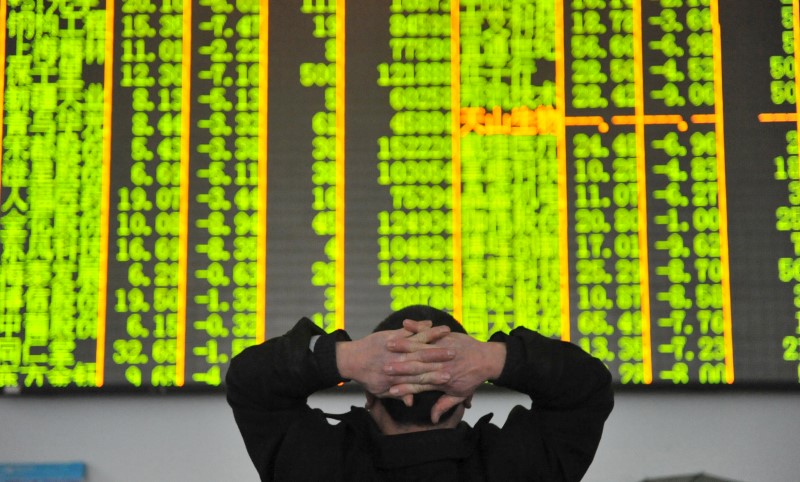By Vidya Ranganathan
SINGAPORE (Reuters) - Asian investors, wary that the region’s stock markets and currencies have run up too far too fast and wondering whether it is time to take some money off the table, are finding that their concerns are not being reflected in major gauges of volatility and fear.
These indicators are supposed to signal red, or at least orange, when stocks are overvalued and risks – whether economic, corporate or political - are building. Currently, they all suggest it is still safe to be invested in riskier assets.
And that is despite the threat of some kind of conflict involving North Korea, or trade tensions between the U.S. and China boiling over, let alone the lingering threat of a China debt crisis.
The Asian indicators are a reflection in Asian hours of the world’s best-known fear gauge, the VIX (VIX), a measure of U.S. stock market volatility, which recently hit an all-time low.
They include the volatility gauge for Chinese stocks (SSEC) (VXFXI), which has been at 18 percent for much of the year, the lowest since 2014.
Meanwhile, one-year implied volatility on the Indonesian rupiah
In the past, some of these indicators have warned of trouble ahead. For example, the VXFXI doubled to 38 percent in the weeks before the June 2015 China stock market crash that wiped out a third of the market’s value within three months, and then rose as far as 58 percent during that turmoil.
Likewise, when the Federal Reserve caused the so-called taper tantrum when it looked like it was going to withdraw stimulus from the global economy in 2013, Asian currencies took a hit. The implied volatility for the rupiah spiked to 18 percent several weeks before the rupiah tumbled.
It is all enough to make some investors wonder whether they are being overly nervous.
"The market is not always rational," said Jian Shi Cortesi, an Asian equities portfolio manager at GAM Investment Management in Zurich. "When we have events happening, then sometimes the market will overshoot on the pessimistic side and everyone runs scared. But if they are not happening, people can get quite complacent," she said.
Cortesi has tweaked the portfolio she manages to include more defensive stocks, which are less vulnerable to economic swings, such as telecommunications companies. But she also points to relatively cheap valuations in some Asian markets, currencies that she says she sees as far from overvalued, and an improving corporate earnings outlook, all as reasons to be cheerful.
DOLLAR DROPS
The U.S. dollar (DXY) is down 9 percent this year, pressured by a host of factors including disappointing U.S. growth and mounting obstacles to Trump's ambitious agenda to reform U.S. healthcare and tax policies.
That is giving investors a fresh reason to pursue Asian stock and bond investments, in the hope of further currency gains. Dollar-based returns so far this year in Indian, Chinese and South Korean stocks are already around 30 percent.
MSCI’s China index trades at a price-to-earnings ratio of 13, quite a climb from levels around 8 after the crash in 2015 but it is still some way from 15 in 2009 and 24 in 2007. The same ratio for Japan’s MSCI index is around 14, half the levels in 2009. The Nikkei index scaled 20,000 in June.
The concern that a weak dollar might erode Asian export earnings or that higher dollar interest rates could hurt global growth seem far removed from investors' radars.
Some strategists say that it is reasonable for prices to stay higher than in the past and for the bull market to continue for another year or two because cheap money from the world’s central banks remains a big support.
"You could say that the risk premium everywhere is very low," said Mirza Baig, head of Asian currency and rates research at BNP Paribas (PA:BNPP) in Singapore. "But then, we have to discuss what is the risk for which there should be a premium."
The threat from North Korea’s rocket and nuclear programs is also being played down by investors, who use history as a guide to assuming the situation will not worsen.
Officials in Washington said North Korea’s latest missile test just over a week ago showed it may now be able to reach most of the U.S. In response to that and other recent missile tests, the United Nations Security Council imposed tough new sanctions on North Korean exports on Saturday.
And yet credit default swaps on South Korean government debt
"The assumption is that it is impossible to take it to the next higher level which would be military action and would have high costs for either side," said Claudio Piron, co-head of Asian currency strategy at BofA Merrill Lynch.
"The market is working on mean reversion. That's what has worked for the past 10 years," he said. Nonetheless, Piron believes that kind of assumption is dangerous, and recommends being short the Korean won
